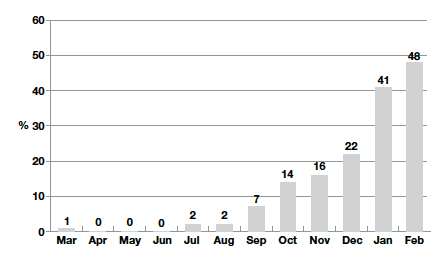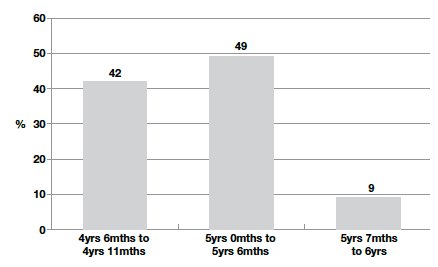Growing up in Scotland: early experiences of primary school
This research report highlights the key findings from the Growing up in Scotland early experiences study.
CHAPTER 2 ENTRY TO SCHOOL
2.1 Introduction
In Scotland, the school year begins in mid-August. Any single school year group consists of children born between the beginning of March in one year and the end of February the following year. Children born between March and August start school in the August of, or following, their fifth birthday. Those born between September and February start school in the August prior to their fifth birthday. As such, children in Scotland usually start school between the ages of 4.5 and 5.5 years old.
However, parents of children born between September and December can request to defer their child's entry to the following August. These deferrals are not automatic and are subject to approval by the local education authority. Parents of children born in January and February may also choose to defer their child's entry; these requests are automatically approved. Children with birthdays in January and February and whose entry to school is deferred are eligible for a further year of funded pre-school education whereas those with September to December birthdays who are deferred are not. Children whose entry is deferred will tend to be aged between 5.5 and 6 years old at the time they start school.
2.2 Key findings
- At school entry, 42% of children were under 5, 49% were aged between 5.0 and 5.5 years, and 9% were older than 5.5 years.
- 87% of children started school in the August when they were first eligible and 13% had their entry deferred.
- Almost half of the children born in January or February were deferred compared with almost no children whose birthdays were between March and August. Fifteen per cent of boys had their entry deferred compared with 9% of girls.
- There were no significant differences in deferral by key parental socio-economic characteristics.
- Parental concerns about the child's development were, however, associated with deferred entry. 21% of parents with some concerns about their child's development at age 5 deferred entry compared with 10% of those parents who had no concerns.
- The most common reasons for deferring entry were that the parent(s) felt the child was 'not ready' (44%) or that he or she was too young (32%). 8% said they deferred for health or developmental reasons and 5% said they had followed advice from the child's nursery or health visitor.
- For deferrals related to the birth cohort, 53% were automatic (involving children born in January or February) and 47% were discretionary (involving children born between September and December).
- When compared with automatic deferrals, discretionary deferrals were significantly more likely to be for health or developmental reasons. Deferrals for children in lower income groups were more likely than for those in higher income groups to be related to health or developmental issues or based on advice received from the child's nursery.
2.3 Entry and deferral
Approximately two-thirds of children in the birth cohort were eligible to start school in August 2009 with the remainder eligible the following August. Looking at all children together, 87% started in the August when they were first eligible with 13% deferring entry. The rate of deferral is marginally higher in the birth cohort than in the child cohort (who started school in 2008 and 2009), where 9% of parents deferred the cohort child's entry.
Figure 2‑ A Percentage of children with deferred primary school entry by month of birth

Weighted base = 439, Unweighted base = 439
As may be expected, key to the decision to defer appeared to be the child's age with those children who were youngest at their eligible starting date most likely to be deferred. Figure 2‑A illustrates the proportion of children whose entry was deferred by their month of birth. The data show that almost half of those born in January or February were deferred compared with almost no children with birthdays between March and August.
The child's gender also appeared to influence the parent's decision to defer. Fifteen per cent of boys had their entry deferred compared with 9% of girls. There were no significant differences by parental level of education, household income or area deprivation. Parental concerns about the child's development were, however, associated with deferred entry. Amongst those who had some concerns about their child's development at age 5, 21% deferred entry compared with 10% who had no concerns. Indeed, gender differences in parental concerns about development may explain, at least in part, the differences in rates of deferral between boys and girls as parents of boys are significantly more likely to report developmental concerns than are parents of girls. For example, at age 5, 27% of parents of male children reported some concerns about their child's development compared with 14% amongst parents of female children. Such findings resonate with earlier analysis of data from the older GUS child cohort which showed that around the time of school entry, parents of boys were more likely to report difficulties with their child's social, emotional and behavioural development 2 than were parents of girls (Bradshaw and Tipping, 2010).
Indeed, around 8% of parents in the child cohort who deferred their child's school entry said they did so for health or developmental reasons. However, as shown in Table 2.1, the most common reason given was simply that the parent(s) felt the child was 'not ready'. The next most common reason was that the child was not old enough, reflecting the differences by birth month shown above. In addition, around 5% said they had deferred following advice or consultation with the child's nursery or health visitor.
Table 2.1 Reasons given for deferring child's school entry - Child cohort
| Reason | % of children deferred |
|---|---|
| Not ready | 44 |
| Not old enough | 32 |
| Health or developmental issues | 8 |
| Chose not to send | 6 |
| Advised to defer | 5 |
| Something else | 5 |
| Bases | |
| Weighted | 190 |
| Unweighted | 228 |
As noted above, Scottish education policy insists that referral requests are treated in two separate ways by local education authorities: requests for children born in January or February are automatically granted whereas those for children born in September to December are discretionary. Overall, for deferrals related to the birth cohort, 53% were automatic and 47% were discretionary. The proportions for the child cohort were different with 69% of deferrals as automatic and 31% discretionary. There is no obvious reason for this difference between the two samples and it may therefore represent a downward trend in applications for deferral or the success of those applications.
Analysis was undertaken within the sub-sample of children in the birth cohort whose entry was deferred to explore whether or not discretionary deferrals were more common amongst particular subgroups. The analysis indicated that, despite there being no differences in overall likelihood of deferred entry by family socio-economic characteristics, where a child's entry to school had been deferred, that entry was significantly more likely to have been discretionary than automatic amongst children in more disadvantaged circumstances.
Figure 2‑ B Percentage of children with deferred primary school entry whose deferral was discretionary by equivalised household income

Weighted base = 422, Unweighted base = 428
For example, Figure 2‑B shows that, compared with families with higher levels of household income, deferrals relating to children from lower income families were significantly more likely to be discretionary (referring to a child with birth month of September to December) than automatic (referring to a child with a birth month of January or February). Amongst lower income families, the split by deferral type is around half automatic and half discretionary, whereas for higher income families around one-third of deferrals are discretionary with two-thirds automatic. As may be expected, there is no variation in birth month by level of household income.
Reasons for deferral varied according to whether or not the request was automatic or discretionary, and according to household income as shown in Table 2.2. Although the dominant reasons related to age and perceptions of 'readiness' remain, when compared with automatic deferrals, discretionary deferrals were significantly more likely to be for health or developmental reasons. In addition, deferrals for children in lower income groups were more likely than for those in higher income groups to be related to health or developmental issues or based on advice received from the child's nursery.
Table 2.2 Reasons given for deferring child's school entry by deferral type and household income - Child cohort
| Reason | Deferral type | Equivalised income group | ||
|---|---|---|---|---|
| Automatic (%) |
Discretionary (%) |
In bottom 3 quintiles (%) |
In top 2 quintiles (%) |
|
| Not ready | 50 | 29 | 39 | 48 |
| Not old enough | 35 | 25 | 31 | 37 |
| Chose not to send | 5 | 7 | 4 | 10 |
| Advised to defer | 5 | 5 | 8 | 1 |
| Health or developmental issues | 4 | 19 | 12 | 3 |
| Something else | 1 | 14 | 7 | 1 |
| Bases | ||||
| Weighted | 135 | 55 | 107 | 66 |
| Unweighted | 147 | 56 | 106 | 78 |
2.4 Age at school entry
As noted above, the entrance policy in Scotland allows that children are eligible to start to school when they are aged between 4.5 and 5.5 years old. However, this policy also allows the flexibility for children at the younger end of the spectrum to have their entry deferred for a year meaning that a small proportion of children will be slightly older than 5.5 at the time of entry.
Figure 2‑C illustrates the typical age range of a Primary 1 class at the point of entry based on the GUS birth cohort data. The data confirm that the vast majority (91%) of children are aged between 4.5 and 5.5 years old with those aged between 5.0 and 5.5 years forming the single largest group. Around two-fifths (42%) are under 5 and just 9% are older than 5.5 at the time of entry.
Figure 2‑ C Percentage of children in each age range at school entry

Contact
There is a problem
Thanks for your feedback